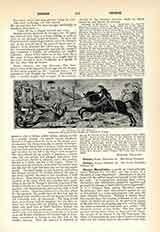

George of Trebizond, a Greek scholar of the early Italian Renaissance; b. in Crete (a Venetian possession from 1206-1669), 1395; d. in Rome, 1486. He assumed the name “of Trebizond” because his family came from there. He was one of the foremost of the Greeks to arrive in Italy (c. 1420) before the fall of Constantinople. Vittorino da Feltre (1378-1446) taught him Latin, and in return he taught Greek in the famous school at Mantua. After teaching for a time at Venice and Florence he came to Rome, and when Eugenius IV (1431-47) restored the University of Rome (1431), one of its most important professorships was assigned to George of Trebizond, who had acquired the highest repute as a master of Latin style. By Nicholas V (1447-1455) he was much sought after as a translator of Greek works—such as the “Syntaxis” of Ptolemy and the “Praeparatio Evangelica” of Eusebius. His incompetence, arrogance, and quarrelsomeness led to difficulties with Bessarion, Theodore Gaza, Perrotti and Poggio, and he was obliged to leave Rome, and take refuge with Alfonso, King of Naples. Under the pontificate of his former pupil, Paul II (1464-1471), he returned to Rome and was appointed a papal abbreviator, but became involved in fresh quarrels; in 1465 he visited Crete and Byzantium, and then returned to Rome, where he wrote the account of the martyrdom of Bl. Andrew of Chios (Acta SS., May 29). He died resenting the obscurity into which he had fallen, and was buried in the Minerva. “George of Trebizond is the most unpleasing of the Greeks of that day. Conceited, boastful and spiteful, he was universally hated” (Pastor, II, 202, note). He sided with the partisans of Aristotle in the controversy raised by Georgios Gemisthos Pleithon (1356-1450). His onslaught on Plato lost him the friendship of Bessarion and led to the latter writing (1464) his great work, “In calumniatorem Platonis”, in the fifth book of which he points out 259 mistakes in Trebizond’s translation of the “Laws” of Plato. His numerous translations included the “Rhetoric” and “Problems” of Aristotle, and St. Cyril’s “Commentary on St. John”, but, as Pastor notes, they are almost worthless (II, 198, note). A list of some forty-six works will be found in Migne, P.G., CLXI, 745-908.
EDWARD MYERS

